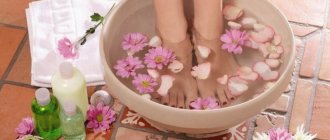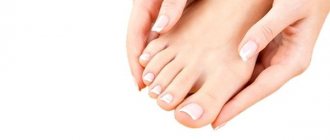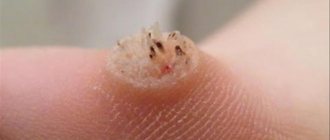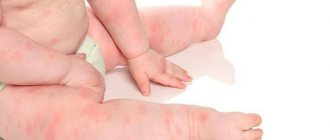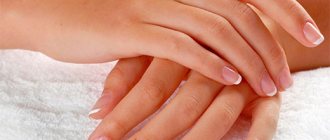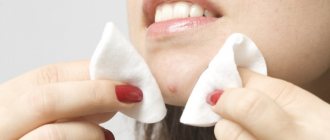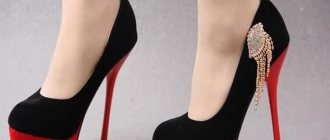A callus is a rough hardening of the top layer of skin. Most often this is due to prolonged pressure or friction due to improperly selected shoes, as well as in the presence of chronic blood flow disorders. What ointment for calluses on the feet will be effective for eliminating growths painlessly and without leaving a trace? Features of the use of each medicinal composition are discussed below.
Cosmo recommends
They will lengthen the neck, emphasize the chest and make the shoulders graceful - 7 tops with asymmetry
Which manicure shortens nails - correcting common mistakes
Calluses are a common problem for many girls. Incorrectly chosen shoes or prolonged walking can lead to pain and skin deformities. If the case is not too advanced, then the callus can be cured at home with pharmaceuticals and improvised means, otherwise you should seek help from a specialist.
How to quickly get rid of calluses at home
Treating water (wet) callus on the heel
Water calluses appear in the heel area or near the Achilles tendon. If the capillaries are affected, the callus will be bloody. Most often, a wet callus occurs as a result of friction and wearing tight shoes.
To get rid of a callus on your heel, follow these steps:
- Wash your foot carefully so that the callus does not burst.
- Apply a special patch for wet calluses.
- Make a pillow from sterile gauze pads.
- Apply to the bubble and secure with a regular band-aid.
- Change the bandage 2 times a day, morning and evening.
- Do not puncture the callus, otherwise there will be a risk of infection.
- If the callus bursts on its own, do not touch the pieces of skin: they serve as protection.
- Wash the callus with chlorhexidine and change the gauze bandage regularly.
- If suppuration occurs, consult a doctor immediately.
Getting rid of dry calluses
A dry callus looks like a small yellowish bump on the skin; it doesn’t hurt much. It occurs from wearing uncomfortable shoes and can develop into a water callus if proper measures are not taken.
Removing dry callus:
- Dilute a bath with warm water, sea salt and soda before going to bed. For 3 liters of water, 1 tablespoon of salt and the same amount of soda.
- Steam your feet for 10-15 minutes, then wipe dry with paper napkins and scrape the callus with a cotton pad or a wooden stick.
- Lubricate the area of damaged skin with zinc paste and try to exfoliate the dead skin. If the callus does come off, leaving a pink mark, then use a rich baby cream. After the procedure, blot off excess cream with napkins and put on socks. If necessary, repeat the procedure after 3-4 days.
How to cure callus
Calluses most often form on the toes. Outwardly, it resembles a dry callus, but has a hole in the middle and affects much deeper layers of the epidermis. Occurs from wearing tight shoes. At home, you can get rid of such calluses using a patch with salicylic acid, which is sold at the pharmacy. It is recommended to wear this patch for 1-2 days and reapply if necessary. You should not try to open the callus yourself, this is fraught with complications.
How to get rid of calluses on your toes
Calluses on the toes are not easy to treat due to constant friction against the inner edge of the shoe. The fastest way to get rid of calluses on your fingers is to walk barefoot or wear open shoes. In other cases, you will have to intervene with the use of pharmaceuticals.
How to get rid of a callus on the little toe
These calluses look like hardened blisters on the very phalanx of the finger. You can get rid of calluses on the little finger using a protective pad of gauze and cotton wool. You need to rinse your finger with warm water, wipe it with a cotton pad with chlorhexidine and lubricate the area with callus ointment, which is sold in any pharmacy. Attach a pad of gauze and cotton wool to the surface of the damaged area using a bactericidal patch. It is important to isolate the rubbed little finger from its healthy counterparts to ensure quick and comfortable healing.
How to get rid of dry calluses on the soles
Calluses on the soles occur due to tight shoes or thin insoles that do not absorb the step, causing the foot to hit the asphalt with special force. Depending on the type of callus (dry or water), treat the sole using the appropriate method described earlier, wrap it tightly with a bandage around it or secure a wide piece of bactericidal plaster over the entire surface of the damaged area.
How to get rid of corns on the feet
Corns occur due to the greatest pressure on an area of skin. They most often appear on the heels, between the toes and on the foot under the toes. The formation of corns is usually associated with flat feet and wearing high-heeled shoes.
- Soak your feet in hot water with sea salt and remove the layer of dead skin with a washcloth and pumice stone.
- The pharmacy sells products for effective foot peeling, which are based on urea, which is necessary to soften skin deformations.
- Use special plasters specifically for the foot area and cotton wool and gauze pads to reduce pressure on the affected area of the skin.
How to get rid of a callus on your foot
Hard shoe bridges can damage the top or side of the foot, where the skin is much more delicate. In this case, it is necessary to treat the callus in a more delicate way. Unlike the rough skin of the sole or toes, the top of the foot is much more sensitive. You need to rinse your leg with warm water, clean the wound with hydrogen peroxide and lubricate it with Levomekol or Rescuer ointment. Cover the wound with a piece of gauze and secure it with a thin layer of bandage or a strip of bactericidal plaster. Change the bandage 2 times a day until complete healing.
Photo: Getty Images
How to brush your teeth correctly: the secrets of a beautiful smile
Is it possible to use iodine or brilliant green?
Iodine is included in some folk remedies for eliminating callus. If you have puffy growths on your fingers or heels, you can smear them with iodine before going to bed, and by the morning the roughness will disappear.
You also need to use iodine and brilliant green in cases where it is necessary to pierce a water callus. But it is advisable to carry out such a procedure only in the most urgent cases in order to avoid infection of the wound.
But if a wet callus has ruptured, then it is not advisable to use such products, since it can further increase irritation of the skin. In each case, it is important to consult a specialist.
If the new growths are wet and inflamed, then in the evenings you need to thoroughly wash and dry them, and only then apply medicinal products. Socks or stockings need to be changed more often, shoes should be worn with low heels, and products made from high-quality materials should be chosen.
Why do calluses appear?
Coarsening of the skin (hyperkeratosis) is the body’s response to constant friction, the desire to protect the affected area. Calluses can occur on any area of the body, but most often occur on the fingers and between the toes, and on the heels. Hardening of the skin does not happen overnight, but over time. Promote the formation of calluses and corns:
- excess weight;
- vitamin deficiency, in particular lack of vitamins A and E;
- uncomfortable, tight shoes;
- metabolic diseases (diabetes);
- fungal skin changes;
- psoriasis;
- flat feet;
- frequent walking barefoot on rocky soil;
- circulatory disorders in the lower extremities.
The problem gets worse with age. Most people seek professional medical help only when the callus causes significant discomfort, becomes very hard and dry, or bleeds or becomes inflamed. Especially painful round calluses, with a core inside. Interdigital calluses are also annoying.
Causes of the formation of corns on the feet
Like calluses, corns have a rather unsightly appearance. Ugly, rough formations of a grayish-yellow color have unclear outlines.
There is no pain when pressing on the corns. The same effect on a callus causes a completely opposite reaction in the body. The fact is that calluses have roots that grow into the tissue. Corns are thickenings that affect only the surface layer of the skin.
Seals on the skin can be flat or convex. Flat corns cause much less inconvenience. Convex ones are more disturbing - they interfere with walking. If left untreated, the corns may crack and swell.
In order to properly treat any disease, it is necessary to know the causes of its occurrence.
It has been established that there are two reasons for the appearance of these unpleasant formations - internal and external.
Internal (endogenous) causes - the appearance of corns as a result of diseases.
Possible causes include: diabetes mellitus, fungal diseases, flat feet, metabolic disorders, skin nutritional disorders, psoriasis.
External (exogenous) causes - prolonged mechanical impact on the skin. As a result, cell death occurs and a rough growth forms. In this case, the most common cause of corns is wearing uncomfortable shoes.
Narrow shoes, thin soles, uncomfortable lasts - all this leads to friction and compression of the foot. In those areas where the foot is more susceptible to friction, corns occur.
Since the formations affect only the upper layers of the skin, their treatment is greatly simplified.
Types and methods of treatment
- hard calluses, which are more common on the little fingers. That is, they form in places where tight-fitting shoes, sandals or boots tend to chafe the most.
- soft calluses can be observed between the toes (especially between the fourth and fifth toes). They are usually moist and soft due to sweat and can sometimes become inflamed.
A fairly large callus often forms on the underside of the foot, under the toes. It is also popularly called “corns”, formed under the influence of mechanical irritation of the skin from shoes or as a result of excess body weight. Some people complain of quite painful sensations, others do not notice its presence.
We list the effective methods of dealing with calluses on the feet:
- Keep your feet dry and friction-free.
- Choose shoes that fit comfortably and without rough seams. If you can't move your fingers when trying them on, look for another model.
- Avoid shoes with tapered toes and high heels, and do not constantly wear flip-flops that hit your heels.
- Repair your shoes or replace them with new ones in a timely manner.
- Prefer natural socks without synthetic threads.
- If your foot is deformed, use orthopedic shoes or insoles.
- In the initial stage of callus development, a hardware pedicure from an experienced professional is a great help.
Advantages and disadvantages of ointment
What is best to use for calluses on feet? In this case, ointment is considered the best remedy. After all, such a drug has many advantages, including:
- Affordable price.
- Quick results.
- Efficiency.
Despite the obvious advantages, ointment for calluses on the feet also has certain disadvantages:
- Some difficulties of application. The ointment should not come into contact with healthy tissue.
- The product is not effective in treating advanced or deep calluses.
- High risk of an allergic reaction.
Folk remedies against calluses
Dry calluses often form on the big toe and look like unsightly bumps. It happens that they make it very painful to walk. We have collected the best tips for treating calluses at home:
- Apple vinegar. Helps soften hard skin, relieve pain, speed up the healing process. Simply soak a piece of cloth or a cotton pad in apple cider vinegar and place it on the affected area overnight. In the morning, use a pumice stone or foot brush.
- Baking soda. Warm baths with this remedy can be done at home every day (10-15 minutes) until the callus has softened and can be easily exfoliated with a pumice stone.
- Aspirin. Well-pulverized tablets (6 pieces) are mixed with lemon juice and water (half a teaspoon each). The medicinal paste is applied to the keratinized skin, covered with a film for 7-8 minutes, and then thoroughly washed off and dead skin cells removed with a foot file.
- Lemon. A bandage soaked in freshly squeezed lemon juice perfectly treats dry, painful calluses. It can be applied at night. Another option is lemon peel attached to the affected area of the skin.
- Onion. Cut a fresh onion in half and then soak it in white vinegar for 3 hours. The cure for calluses is ready. Onions marinated in this way are applied to calluses overnight.
- Castor oil. An excellent moisturizing and nourishing product for rough dry skin, eliminates microcracks and unevenness. It is applied to the callus area for 10 minutes every day until the unpleasant bump is eliminated.
- Sea salt. A paste of sea salt and olive oil, applied for 15-20 minutes with massaging movements, helps reduce discomfort due to calluses on the feet.
- Chamomile. This natural anti-inflammatory agent is used in foot baths to quickly soothe pain and reduce the thickness of the growth.
- Vitamin E. It is recommended to apply a few drops of vitamin E to dry calluses for 1-2 weeks.
- Garlic. A plate of fresh garlic is applied to the callus area for 1 minute, then the skin is allowed to dry and the area is washed only in the morning.
- Turpentine oil. It is a powerful antiseptic and is used to get rid of calluses. Apply at night.
- Turmeric. It has an anti-inflammatory effect and accelerates the healing of calluses on the feet. It is recommended to carry out procedures with a thick mixture of turmeric and honey 2-3 times a day for a week.
- Potato. In its raw form, potato juice brings positive results in the treatment of interdigital calluses. It has a cooling effect and helps relieve dry skin.
- Raisin. An excellent home remedy for calluses, used as a bandage at night.
- Glycerol. It is lubricated with coarse structures and gently massaged for at least 5 minutes.
- Olive oil. Eliminates burning and pain from calluses, makes the skin soft.
- Massage. To improve blood circulation in the legs, reduce pain in the heels, and get rid of cracks and corns, massage is excellent.
In addition to home remedies for treating calluses, to better exfoliate the stratum corneum on the feet, use special scrubs, lotions, and ointments based on salicylic acid. Pharmacies offer callus plasters, calluses with celandine extract, and creams with urea. It is better if the treatment is carried out under the supervision of a doctor.
The easiest way to remove dry calluses is in the office of a dermatologist-cosmetologist. Thanks to the most modern treatment methods - cryodestruction, laser and radio wave therapy, diathermocoagulation - it is possible to forget about the problem forever.
Wet calluses must be treated up to 3-4 times a day with wound-healing antiseptic solutions: furatsilin, hydrogen peroxide, chlorhexidine, betadine; if necessary, use antibiotic ointment.
First aid
A callus can appear on any part of the foot, but the heel is most often affected. How to quickly cure a callus that has burst on the heel:
- Remove the affected leg from shoes and clothing (socks, tights);
- Wash your hands with soap;
- Gently wash the area around the lesion with warm water and soap, being careful not to get any liquid into the wound;
- Treat the burst callus with any antiseptic (furatsilin solution, hydrogen peroxide, light pink solution of potassium permanganate);
- If the liquid inside the wound is free of blood, and the callus itself has not affected a large area of skin, you can fill the wound with BF-6 medical glue. The burning pain lasts literally 1-2 minutes. But then the wound is covered with a thin protective film, which prevents infection. A bactericidal patch should be glued on top of the treated surface;
- If the affected area is large, the wound should be smeared with antimicrobial ointment (Levomekol, Streptotsidovaya, Liniment synthomycin, etc.). Then it is recommended to apply a sterile bandage, which must be changed 2-3 times a day, while the ointment will protect the wound from infection by microbes and the bandage sticking.
First aid for burst calluses:
Is it possible to smear calluses with brilliant green and iodine? This is of interest to patients who often develop dropsy. If you use the product on an open wound, you can get burned. In addition, the drugs greatly dry out delicate skin, causing cracks to appear on it.
If the surface of the dropsy is not broken, treatment is carried out using disinfecting compounds over the skin covering the wound. Zelenka protects it from inflammation. Potassium permanganate is used for daily baths, which speed up healing.
What to do if a callus on your foot bursts outside the home:
- Apply a plantain leaf to the wound with the glossy side, after washing or wiping it from dust and dirt. Put a sock on top;
- Pluck several carved yarrow leaves, chew them thoroughly until a homogeneous mass is obtained, and cover the wound with the resulting composition;
- If you don’t have familiar medicinal plants at hand, stick a leaf of birch, oak, poplar, or maple on the affected area;
- Remove the shoes that are rubbing your feet, otherwise the blister may break.
Arriving home, you should quickly and thoroughly treat the callus that has burst on the heel.
At the site of friction, the skin dies. A blister forms, in which fluid saturated with leukocytes accumulates. It protects the wound from microbes and promotes the regeneration of damaged cells.
If you feel pain, you need to take off your shoes, wipe your foot with a bactericidal wipe, dry it and treat it with an antiseptic, for example, hydrogen peroxide. Then cover the injured area with a bactericidal plaster and try to avoid further irritation of the foot.
Due to pressure on the walls, large bubbles often burst. Intercellular fluid leaks out. This is a dangerous situation. Rupture of the film opens the wound, allowing sweat and dirt to enter, which are sources of infection.
- The foot should be thoroughly washed with laundry soap. Fill the wound with Furacilin, peroxide, Chlorhexidine. If you don’t have an antiseptic on hand, you can prepare a weak solution of potassium permanganate and use it for treatment.
- Broken skin cannot be torn off. Without it, the wound will take longer to heal. It is necessary to apply antibacterial ointment, wait 10 minutes for it to absorb a little, and cover with a sterile bandage. A small callus can be covered with a band-aid.
- Dressings should be done twice a day, maintaining sterility. Open the callus at night so that the wound does not get wet, but dries out.
If everything is done correctly, after 4-5 days the integrity of the epidermis is restored.
We suggest you familiarize yourself with How to get rid of edema and excess fluid in the body? Water Diet
How to treat dry calluses with a callus on the toe using folk remedies?
The corns core is a rather painful formation. It puts pressure on nerve endings, causing discomfort. Common calluses can be removed from the feet through softening procedures. How to treat corns? Corns with a rod inside require more serious treatment.
How to cure corns on feet? For many years now, corns on the soles of the feet have been treated, including with folk remedies. Despite the fact that folk recipes are inferior to traditional medicine, nevertheless, with constant procedures and compliance with all rules and recommendations, they can be very effective.
So, how to remove dry callus, how can you quickly get rid of the “rods” at home? For this purpose, baths, ointments and compresses are used.
Instructions for use
The ointment is used in surgery, for introduction into the cavity as a healing agent through drainage tubes, as well as for therapy for gynecological problems, in dentistry and for diseases of the upper respiratory tract and nasopharynx.
The product is designed to eliminate pathogenic bacteria and pathogens, both from the skin and mucous membranes. Before using Levomekol ointment, you need to know what the product is used for and what organisms it neutralizes. The drug is effective against rickettsia, chlamydia, staphylococcus, spirochetes, as well as Escherichia coli and Pseudomonas aeruginosa.
When the drug acts on pathogenic bacteria, the active substance penetrates into the cell without disturbing the structure of the membrane and prevents the process of protein formation. Such exposure leads to the death of microorganisms.
With prolonged use of Levomekol ointment for external use, the body does not have the opportunity to get used to the drug. Therefore, the drug exerts its effect quite effectively, fighting infections and blocking the formation of purulent exudate.
The presence of purulent content in an open wound does not prevent obtaining a positive result when using Levomekol ointment. If the danger of exposure of active components to human internal organs is identified, the drug belongs to the group of low-hazard medications.
When applying Levomekol ointment to the upper layers of the epidermis, the consistency of the product becomes liquid, is well absorbed into the soft tissues and relieves redness, helping to neutralize the inflammatory process.
During application, in addition to the antimicrobial and antibacterial effects, swelling in the affected area is eliminated. The process is carried out using a dehydrating effect and reducing the size of free intercellular fluid.
Before using Levomekol ointment, you need to consider the indications for use. There are situations in which the use of medication is mandatory:
- Burn of an arm, leg or other part of the body of II and III degree;
- Balanoposthitis in men;
- Open wounds with pus;
- Furunculosis;
- Skin diseases with the presence of inflammation;
- Trophic ulcers, bedsores;
- Treatment of sutures after difficult childbirth;
- Sinusitis, sinusitis;
- Inflammation of the middle ear (otitis);
- Skin rashes (acne, rash, urticaria);
- Inflammation of the mucous membrane in the oral cavity;
- Manifestation of hemorrhoids.
In addition, the drug Levomekol has established itself as a healing ointment for wounds. The product quickly copes with herpes that has developed on the lips or face. It is used to treat skin surfaces, including burns.
Doctors recommend using Levomekol as a preventive measure as an ointment for bedsores for bedridden patients or young patients. Levomekol quickly copes with inflamed calluses, especially on the feet, as well as with eczema and cuts. Therefore, in order to start using a medicine in the first stages of the development of a problem or disease, you should know what the drug helps with.
Baths
With hydrogen peroxide
- To soften rough skin on the feet, take 1 liter of not too hot water and add 2 tablespoons of peroxide.
- Feet should be kept in the bath for 15-20 minutes, after which the dry skin is removed with a pumice stone, and cream is applied on top.
This procedure can be repeated until the growth is completely eliminated.
From whey
A whey bath works well with cracks and growths
- The whey is preheated to 40 degrees.
- Feet should be kept in it for 25 minutes.
- Then rinse with water, use nourishing cream and put on a sock to keep warm.
- Repeat the procedure once a week until the corns are completely eliminated.
With mustard
- For 2 liters of water add 2 tbsp. mustard.
- The water should be moderately hot so that it can steam the callus on the toe, after which the top layer is removed with a pumice stone.
How to remove dry callus? The course of treatment is carried out individually. Baths should be done until the callus completely disappears.
With laundry soap
- Laundry soap is grated on a grater.
- Tbsp. grated soap dissolves in a liter of water.
- The water should be at a temperature of 37°C.
- The bath is taken for half an hour, then the steamed callus is also removed with a pumice stone, and baby cream is applied to the place where it was.
With sea salt
Foot baths can be taken with sea salt . It works quite effectively on the feet to get rid of corns.
With baking soda
- 1 tbsp dissolves in hot water. liquid soap and 3 tablespoons of baking soda.
- Soda can be replaced with mustard powder.
- Feet are steamed for 30 minutes.
After your feet have been steamed in the prepared bath, you can try to remove the callus by gently pulling it by the cap. It may not work out the first time, but you shouldn’t put in much effort. It is better to repeat the procedure again.
How much does Levomekol ointment cost?
The price of Levomekol ointment in Moscow is from 46 rubles. The price of Levomekol in Ukraine is from 7.2 UAH.
An ointment dressing with levomekol VoskoPran can be purchased for an average of 320 rubles. for package No. 5. The average cost of the same package in Ukrainian pharmacies is 420 UAH.
- Online pharmacies in RussiaRussia
- Online pharmacies in UkraineUkraine
- Online pharmacies in KazakhstanKazakhstan
ZdravCity
- Levomekol ointment 40gNizhpharm OJSC
- Voskopran anti-inflammatory wound dressing with levomekol ointment 10×10 cm. 30 pcs. Biotekfarm/New Dressing materials
- Voskopran anti-inflammatory wound dressing with levomekol ointment 7.5×5 cm. 5 pcs. Biotekfarm/New Dressing materials
Pharmacy Dialogue
- Voskopran Levomekol ointment (bandage 10x10cm No. 10)New Dressing Materials
- Levomekol ointment (tube 40g) Nizhpharm JSC
- Voskopran Levomekol ointment (bandage 5x7.5 No. 5)New Dressing Materials
Europharm* 4% discount using promo code medside11
- Levomekol ointment 40 Nizhpharm OJSC
show more
Pharmacy24
- Levomekol 40 g ointment PAT NEC "Borshchagivsky chemical-pharmaceutical plant", Kiev, Ukraine
- Levomekol 40 g ointment PrAT FF "Viola", Ukraine
- Levomekol 40 g ointment PAT "Farmak", Ukraine
- Levomekol 25 g ointment PAT "Lubnifarm", Ukraine
- Levomekol 40 g ointment PAT "Khimpharmzavod" Chervona Zirka", Kharkov, Ukraine
PaniPharmacy
- Levomekol ointment Levomekol ointment 25g tube Ukraine, Lubnyfarm PJSC
- Levomekol ointment Levomekol ointment 40g Ukraine, Red Star OJSC
- Levomekol ointment tube 40g Ukraine, Red Star
show more
Compresses
- Feet with corns are steamed every day for a week. Then a lemon peel with pulp is applied to the sore spot and bandaged. When the lotion is removed, the exfoliated skin is removed with a pumice stone. The acids contained in lemon can soften rough tissue.
- In addition to lemon peel, you can use grated onion gruel for a compress. After application, the leg is wrapped in cellophane, and a sock is put on top for fixation. In the morning after waking up, the feet are washed, the keratinized skin is removed with a grater or pumice stone.
- Prunes are boiled for 15 minutes in a glass of milk. Then cool and knead into a paste used for compresses.
- Potato peelings are ground in a blender. Then the pulp is wrapped in gauze and attached to the corn before going to bed. In the morning, the problem area is treated with an abrasive.
- A compress can be made by mixing garlic with lard.
- One of the most effective remedies against calluses is considered to be a celandine compress. Fresh celandine is crushed into a paste and applied to the affected area of skin at night. The procedure should be repeated 5 times. The gruel will relieve pain and promote the regeneration of damaged tissue.
- If celandine is not at hand, aloe leaves cut in half can successfully replace it. They are applied to the callus with the side from which the juice flows, then the leg is wrapped in cellophane, a bandage is applied on top and a warm sock is put on. Before using aloe, it is better to keep it in the refrigerator. Apply at night, remove in the morning and remove damaged skin.
- Propolis can also be used as a compress. It is pre-kneaded and applied to the problem area.
- Thoroughly chewed bread crumb is soaked in vinegar. Apply to the leg at night, and repeat the procedure in the morning.
- A compress of grated tomatoes will also be useful. It is used in the same way as all the above-mentioned means.
To prevent this, a hole the size of a callus is cut in the patch. itself is glued to the leg, and a compress is applied on top . Healthy skin will be protected, and the compress will directly affect the problem area of the skin.
- Vinegar.
Mix 1 tbsp. vinegar (70%) with 1 tbsp. vegetable oil and 1 raw egg.
The resulting mass should stand in the refrigerator for at least a day.
Use for at least 5 days. Vegetable oil.
You can use regular vegetable oil as an ointment.
After applying it to the callus after taking a hot bath, it is better to wear warm socks on top.
This simple method will help soften the growth and reduce its size.
Vinegar essence.
You can also use vinegar essence for lubrication.
Healthy skin is protected with an adhesive plaster, and the callus itself is smeared with vinegar.
The procedure is repeated daily until the callus is gone.
It is recommended to use nail scissors to remove loose callus skin. They must first be disinfected.
Analogues of Levomekol
Level 4 ATX code matches:
Synonyms: Levomethyl , Netran .
Analogues of ointment, similar in mechanism of action: Levomycetin , Levosin , Lingesin , Protegentina ointment , Streptonitol , Fastin 1 .
In gynecology and for hemorrhoids, Methyluracil suppositories can be used as an analogue of the drug in some cases .
Levomekol or Vishnevsky ointment - which is better?
The basis of Vishnevsky's ointment is xeroform , birch tar and castor oil . Levomekol has a local anti-inflammatory and antimicrobial effect , the use of Vishnevsky ointment gives local irritant and antiseptic effects .
Levomekol is prescribed mainly for the treatment of severely inflamed, festering, infected wounds (in the wound inflammation phase). Vishnevsky ointment , according to Wikipedia, is used mainly in the regeneration phase of the wound process: balsamic liniment stimulates tissue repair and granulation in a regenerating wound.
How to quickly cure a callus?
Calluses are an unpleasant thing. Is it possible to get rid of it using folk remedies? Are there any ointments for quickly treating this scourge? Answers to these and other questions can be found in our article.
So what is a callus? A callus is a rough area of skin. What causes such compactions? The most common cause of this type of problem is shoes that are too tight or new. Sometimes, it is worth noting, calluses also appear due to improper care of the skin of the feet and hands.
Types of calluses
There are three types of calluses:
Each variety has its own means of treatment.
Dry calluses occur when rubbed. The skin becomes rough and sometimes swells in the damaged area. A water blister is a “ticking time bomb” that may already bleed. The first looks like a bubble filled with connective fluid, under which, if the bubble bursts, there will already be a bleeding callus.
Many people believe that it is necessary to get rid of dropsy by piercing it - this opinion is erroneous; an infection can get into the resulting wound.
Folk remedies for calluses
- Lemon. Everything that nature has invented can and should be used. So, to treat dry calluses you will need an ordinary lemon. Place a slice of citrus on the rough area of skin. Before this procedure, the place where the callus has formed needs to be steamed.
- Potato. At night, lubricate the seal with Vaseline, then place a slice of potato on the callus. Cover the slice with cellophane and bandage it. In the morning the callus will be much softer. Steam the area with rough skin in a hot bath and remove the annoying callus with a pumice stone or nail file, and then apply a softening cream.
- Onion. If there are no potatoes in the house, and this can also happen, you can use onions to soften the annoying callus. So tie a slice of the above-mentioned vegetable to the seal. In the morning, the softened callus can be removed with a file. After treatment, the skin will need to be thoroughly washed and powdered with talcum powder.
- Onion peel. You need to take onion peels and soak them in a vinegar solution. Wash the affected area, steam it, put the figs in for a short time, then wrap the husk with a bandage to the rough skin (it is advisable to carry out all these steps before bedtime).
- Bread is, it is worth noting, another remedy for combating calluses. You need to apply oil to the bread crumb, and then put it on the seal. Fix this “sandwich” on the damaged area. It is advisable to carry out this procedure at night. If you have time, you can arrange a massage session for yourself: wash and steam the skin, then apply vegetable oil to the corns and massage. After 4 days, the callus should soften and disappear.
- Propolis. The place where there is a callus needs to be steamed (preferably in chamomile decoction), wipe the skin, grind propolis and apply to the affected area, then apply a bandage or stick on an adhesive plaster. Repeat this procedure until the seal disappears.
- Baths for calluses. Recipe - 1 tbsp. add a spoonful of soda to 3 liters of hot water. No soda - take soap (50 g) and salt (2 teaspoons). Add 3 liters of water to this simple mixture. Afterwards, all that remains is to steam the place where the callus has formed and remove the rough skin with a pumice stone or file, and then lubricate the skin with a softening cream.
How to apply ointment
The most unpleasant thing is the treatment of calluses on the feet. Ointments cope well with such problems. The main thing is to follow the instructions and apply the product correctly to the damaged area. Use various ointments with extreme caution. The drug should not come into contact with healthy areas of the skin. To prevent this from happening, you can use a patch. A hole should be cut in the middle of the material, the dimensions of which correspond to the size of the callus.
The patch should be fixed so that the seal is open and the healthy tissue around it is closed. After this, you can use a remedy for calluses on your feet. The ointment should be slightly absorbed after application. Then it is recommended to cover the callus with a clean plaster.

